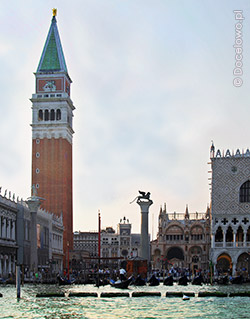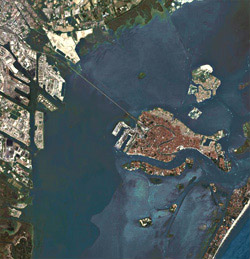Venice today
Venice is very popular among travelers visiting Italy. Worldwide fame gave it primarily the number of channels, on which floated lazily gondolas and lack of typical roads…
Also can’t be forgotten unparalleled architecture, which consists primarily elegant palaces and ancient temples. One of the most famous is St Mark’s Basilica.
With Venice also are associated the gondoliers, and carnival, during which the necessary props are Venetian masks. In addition, the city is regarded as an opera capital of Europe. Suffice it to say that for a time lived here Antonio Vivaldi, and in the twentieth century, staged here Igor Stravinsky’s only opera, entitled “The Life of Lecher”.
Venice is a very popular destination for visitors looking for beautiful views, music, break from everyday life. It’s the perfect place for all those who want an unforgettable experience surrounded by unusual tourist attractions. Really is worth to get a trip to the city, despite the fact that in the history of modern Italy, Venice no longer plays such a big role as before.
Venice – History
The first mention of Venice comes from 452, when settled in these areas people fleeing the barbarian Huns tribe. Over time, the city came into possession of the Byzantine Empire. Under its influence was not too long; fairly quickly regained independence.
In the first centuries Venice was a state-city (on the model of the Greek polis) with republican regime. Its head was the Doge of Venice (doge – prince). Although the urban aristocracy chose him, guaranteeing tenure, in practice the Doge very often was forced to resign.
 At that time it was a multinational, multicultural and multireligious state. On the one hand, Venice was lying near Rome, and therefore underlied to the jurisdiction of the Pope, on the other hand in the country there was freedom of religion. It was understood, however, quite arbitrarily, as proofs the fact that Giordano Bruno was arrested as he preached his views.
At that time it was a multinational, multicultural and multireligious state. On the one hand, Venice was lying near Rome, and therefore underlied to the jurisdiction of the Pope, on the other hand in the country there was freedom of religion. It was understood, however, quite arbitrarily, as proofs the fact that Giordano Bruno was arrested as he preached his views.
Venice formerly inhabited both Italians, Greeks and Slavs. In the circle of their interests were the eastern Mediterranean. Venice controlled, among others, Adriatic, Aegean Islands, Crete, Cyprus, Corfu and many other islands.
The history of Venice consists also conflicts with the papacy and the fight against other nations. The most serious clashes with the Bishop of Rome took place during the pontificate of Julius II, when Pope organized against Venice the League of Cambrai. Also fought with Muslim Turks. The cause of these wars was trading with the East. Venice has preserved its influence, particularly those related to traffic silk and spices. When Vasco da Gama reached India and there was fighting between the Portuguese and Arab traders, Venice was supported by the Portuguese. Unfortunately, they suffered defeat and therefore the importance of Venice began to wane.
At the end of the eighteenth century, the state-city was conquered by Napoleon. Under the Peace of Campo Formio incorporated Venice to Austria. March 17 1848 (during the Spring of Nations) shortly declared independence of Venice. Finally, in the nineteenth century Venice was incorporated into Italy. It is assumed that this was the longest existing republic in the world.
At the end of the eighteenth century, the state – the city was conquered by Napoleon. Under the Peace of Campo Formio enabled Venice to Austria. 17 March 1848 year (during the Spring of Nations) shortly declared independence of Venice. Finally, in the nineteenth century was incorporated into Italy. It is assumed that this was the longest existing republic in the world.

